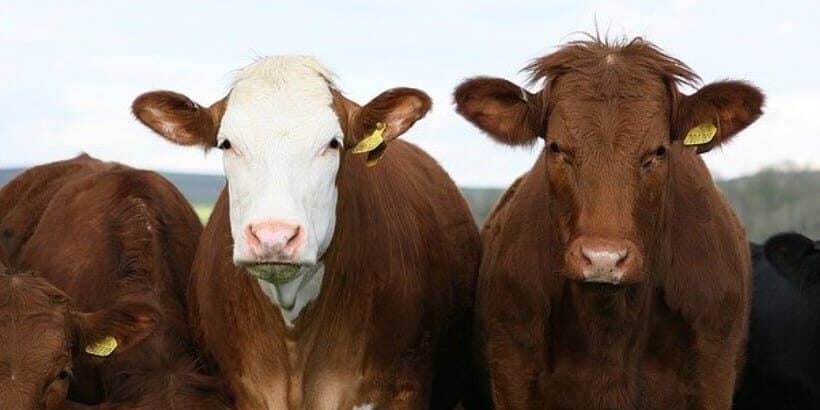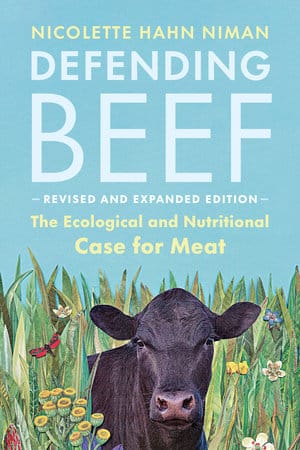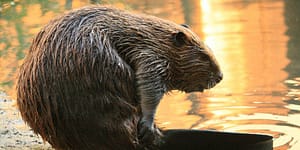Defending Bovines, Butter, and Beef

Beef and dairy products have received a fair amount of backlash within the last decade or so. We have been told that beef is a big proponent in the increase of obesity and other chronic diet-related diseases, as well as dramatic environmental damage. However, more and more people are speaking out that this is not the case.
The following is an except from Defending Beef by Nicolette Hahn Niman. It has been adapted for the web.
We’ve all heard the narrative so often—the one about how red meat, beef in particular, is killing us—that many of us have come to accept it as incontrovertible truth. It’s so common it’s common knowledge. The story goes something like this:
Americans once raised cattle, pigs, and sheep on small, mixed farms scattered around the country, sprinkled with handfuls of livestock. Animal numbers were low and, correspondingly, Americans ate dainty portions of animal fat and red meat. We were thin. Hypertension, stroke, and heart disease rates were low. Environmental damage from farming was minimal. Over the course of the 20th century, however, everything changed for the worse. Livestock herds ballooned. Cattle overgrazed. Red meat and animal fat became abundant, cheap, and ubiquitous. Americans gorged themselves on hamburgers, butter, and ice cream. The result: soil erosion, water and air pollution, and skyrocketing rates of obesity and chronic diet-related diseases.
There’s just one problem with this narrative: It’s fiction.
Yes, parts are correct. But facts that rarely make it into mainstream discussions and media coverage diametrically oppose the narrative’s key elements. As this book will make clear, aspects of the United States’ environmental condition have, indeed, worsened, and chronic diet-related diseases have become more widespread and severe. But these problems cannot reasonably be connected with bovines, butter, or beef. Why?
Because there are about the same number of cattle on the land today as there were a century ago. And while Americans are taking in more calories overall, they are eating less red meat in general, and less beef in particular, than at any time in recent history. We are also consuming less butter, far less whole milk, and much less saturated animal fat. No swelling bovine herds. No ever-heftier helpings of red meat or beef fat. From these facts alone, the simplistic narrative collapses.
If you are skeptical, I won’t blame you. What I’ve just said likely runs counter to what you’ve heard from various sources for many years. But I come armed with data, and plenty of it, all from official government sources. While my overall premises—that cattle are good for the environment and that beef, butter, and cheese are healthy foods—are, admittedly, controversial in this day and age, the basic agricultural and demographic facts are not in dispute.
Here is the most pertinent point to keep in mind. In the second half of this book, I will detail how American diets have changed. I will show we eat less beef and less animal fat now than we did 100 years ago, while our consumption rates for sugar, grain, and industrial vegetable oils have skyrocketed. I will present facts strongly supporting the conclusion that our sugar, flour, and vegetable oil consumption rather than red meat and animal fats are to blame for the sharp rise in obesity and chronic diseases.

Greater output in the beef and dairy sectors has actually not resulted from swelling herd sizes. On the meat side, this is because animals are now slaughtered at much younger ages. At the dawn of the 20th century, a typical beef steer was sent to slaughter at four or five years of age1. Today, to lower costs, and enabled by grain feeding and growth hormones, that steer is killed younger than two years old, typically around 14 months.2 Dairy cows, too, go to slaughter at much younger ages (often just three years old). This also affects beef supply because, now, as always, a large portion of US beef comes from dairy cattle.
The rise in milk production, however, is owing to another issue. As I detailed in my book Righteous Porkchop, selective breeding of dairy cows for greater milk output (read: large bodies and huge udders) has vastly increased per-animal production.3 At the beginning of the 20th century, average US annual per-cow milk output was 2,902 pounds (348 gallons). Today it is 22,774 pounds (2,734 gallons) per year. This is often touted as a major victory for humanity. But the scale of the increase (more than sevenfold) suggests selective breeding has been pushed to an extreme. (Indeed, many of today’s mature dairy cows even have trouble walking, something I have personally witnessed, with heavy heart, numerous times.) The net effect of this change has been a substantial shrinkage of the US dairy herd over the past century.
These factors, combined with the near disappearance from American agriculture of oxen, mules, donkeys, and horses as animal draft power, means there are fewer larger farm animals in the United States now than there were a century ago.
For those of you who may still find this hard to believe, here are the specific numbers. Since 1900, beef cattle numbers rose, but less than people tend to assume, going from 67 million to 94 million. Pig numbers have also gone up, but not much: In 1920, there were 60 million pigs; in 2018, 74 million. On the other hand, sheep numbers plummeted, going from a high of 46 million in 1940 to 5 million today. Likewise, the dairy cow herd shrank dramatically, from 32 million down to 9 million, over the past century. And draft animals have gone from 22 million in 1900 to just 3 million in 2002. All told, that means that while early-20th-century farms and ranches had roughly 99 million head of cattle and 227 million larger animals (including cattle), today they have 103 million cattle and 185 million larger animals. That’s a modest 4 percent increase in cattle numbers and an overall 19 percent reduction in larger farm animals.
From an environmental standpoint, two issues are most relevant: How many animals are in inventory, and, more important, by what methods are they being raised? These factors will largely determine ecological footprint—harmful or helpful. As we’ve just seen, there are only slightly more cattle today than for much of the past century. At the same time, cattle are being raised with more care: There is a burgeoning movement within agriculture to thoughtfully manage grazing. This is increasingly transforming animal impact into a cornerstone of regenerative agriculture.
From a diet and human health perspective, the central questions are: What’s being consumed, and in what form? Are we eating real, whole, unprocessed vegetables, fruits, nuts, grains, eggs, fish, and meats or, in contrast, “edible food-like substances,” as Michael Pollan calls them in his book Food Rules? Americans today consume less beef and butter but far more processed foods. Fast food, packaged snacks, and sweet drinks for starters. We all know a bowl of potato chips is junk food whereas a baked potato is satiating and nourishing. Similarly, a mass-produced hot dog is wholly different from a steak.
How much processed food one eats is proving to be the most important variable for health. Whether a food is healthful or harmful is also affected by how it was raised.
It’s essential to acknowledge these facts when we talk about meat. If we recognize that total cattle numbers have been fairly stable and beef consumption is down, it immediately casts serious doubt on the all-too-common narrative that blames cattle and beef for our current environmental and public health crises. I would not expect these facts, on their own, to dissolve the concerns of beef ’s critics. But I hope clarifying these questions at the outset will allow readers to consider this book with an open mind.
I strongly dispute the charge that cattle and beef are responsible for the globe’s environmental and human health problems. But aspects of the popular narrative I mentioned at the outset are correct, and they need immediate and sustained attention. Serious environmental degradation the world over has been caused by agriculture, including the cattle and beef sectors. Like much of American agriculture, the beef industry has become too dependent on manmade inputs like insecticides, fertilizers, hormones, and other pharmaceuticals. Until just the past few years, there has also been widespread failure to grasp soil biology as the essential foundation of truly regenerative farming. Many involved in mainstream farming, including those raising cattle, have failed to prioritize generating nutrient-rich, health-sustaining human foods. Simply put, industrialization has radically altered the way humans farm and eat, much of it for the worse. These issues will be explored in this book.
Current US food and farm policies subsidize output. Much of what is incentivized are destructive practices. Only a tiny portion of subsidies encourage ecological farming methods. Those same policies foster excess production of the unhealthy foods we are already overconsuming and that are making people sick. All of which contributes to underemployment, cheap food, overeating, waste, and environmental damage.
This book is at once a defense of cattle and beef, and an indictment of aspects of modern agriculture and diets. Change in both arenas is urgently needed. The United States is the globe’s top beef producer.4 We can, and should, lead the world in forging ways of raising cattle that reverse environmental degradation and produce healthy, nutrient-rich foods.
For me, it comes down to this: Cattle are central to the human story. We have lived alongside them for tens of thousands of years. Our close connection with cattle has boosted our bodies’ immunity, enabled our migrations, and provided us with intensely nourishing, delicious foods. Done with care, cattle husbandry enriches our human experience and enhances the natural world. We must move well beyond simplistic solutions like banishing cattle from our landscapes and beef and butter from our plates. Instead, it’s time to focus on improving how we raise cattle and turn them into food. Only then can we tap into the full ecological and nourishment potential these remarkable creatures provide. As my friend Russ Conser has said, “It’s not the cow, it’s the how.”
Whether you are among the critics or the defenders of beef, if you come along on this journey, you will find things to agree and disagree with along the way. Whatever your perspective at the start, I hope by the end you will see things in a new and different light.
Notes
1. R. R. Snapp, Beef Cattle: Their Feeding and Management in the Corn Belt States, 3rd ed. (Wiley & Sons, 1939), 16.
2. See N. Hahn Niman, Righteous Porkchop: Finding a Life and Good Food Beyond Factory Farms (HarperCollins, 2009), chapter 7, “Beef, the Most (Unfairly) Maligned of Meats.”
3. Hahn Niman, Righteous Porkchop, chapter 8, “The (Un)-Sacred Milk Cow.”
4. The United States is actually fourth (after India, Brazil, and China) in the number of cattle, but it produces the most beef. BEEF Magazine, August 13, 2013, beefmagazine .com/cattle-industry-structure/industry-glance-beef-cow-inventory-over-time.
Recommended Reads
All About Cows: What has Four Legs, Says “Moo,” and Could Save the Planet?
Recent Articles
The Garlic Clove! This small crop adds a big punch of flavor that complements almost every delicious dish you could think of. And the best part? These two recipes are a breeze to make together!
Read MoreBeavers are ecological and hydrological Swiss Army knives. Capable of tackling just about any landscape-scale problem you might confront.
Read MoreOur love affair with amaranth began long before the pseudo-grain became a trendy staple for gluten-free folk. The luscious leaves of this annual plant are not only packed with a plethora of health benefits.
Read MoreDon’t know where to start for foraging wild plants? Read on for the information you need to begin foraging on your own: where to do it and how to be safe.
Read MoreWhen you’re walking around the grocery store looking at the vegetables, it’s probably hard to imagine that a century ago there was twice the amount of options.
Read More









